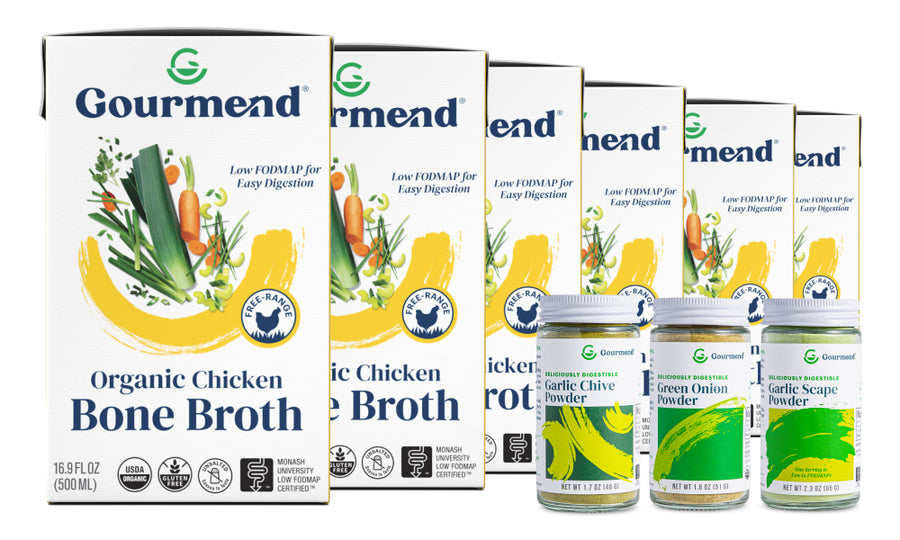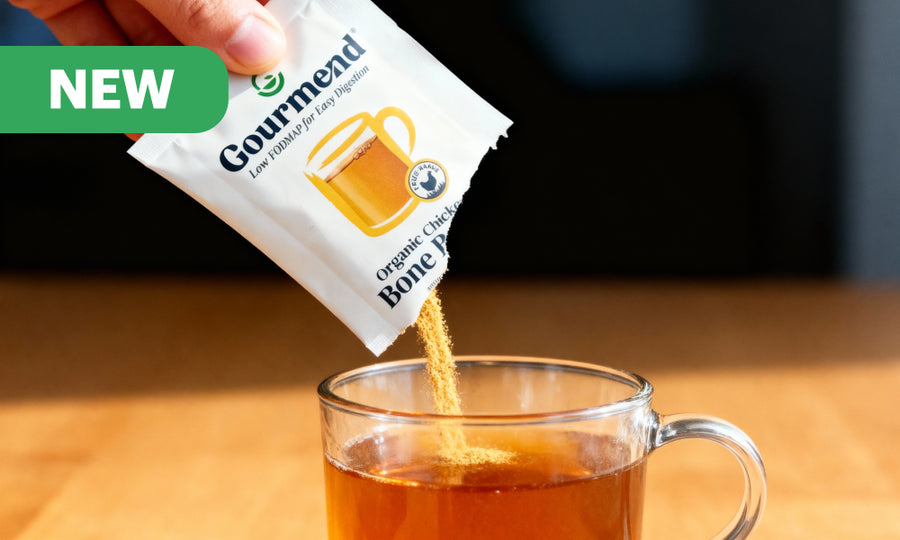Is Butter Low FODMAP? The Complete 2025 Guide

Understanding the Low FODMAP Diet and IBS
If you're dealing with IBS symptoms and wondering "is butter low FODMAP", you're not alone. With nearly 1 billion people worldwide living with IBS and two-thirds of Americans experiencing digestive issues, understanding which foods support gut health has never been more important. For a comprehensive overview of FODMAPs, check out our FODMAP blog for in-depth guides and tips.
Key Takeaways
- Butter is low FODMAP and safe to consume on a low FODMAP diet.
- Standard servings of butter contain only trace amounts of lactose, less than 1g per 100g.
- Butter’s lactose content is well below the thresholds that trigger FODMAP-related symptoms.
- Understanding which foods are low FODMAP is crucial for managing IBS symptoms.
- Digestive health concerns affect a significant portion of the global population, highlighting the importance of diets like low FODMAP.
Table of Contents
What Is the Low FODMAP Diet?
The low FODMAP diet is a clinically tested eating approach designed to reduce symptoms for people with irritable bowel syndrome (IBS). FODMAPs are short-chain carbohydrates that can trigger digestive discomfort—including bloating, gas, and stomach pain—in sensitive individuals. For more on the science and clinical background, see this Harvard Health article on the low FODMAP diet.
Key Fact: Research shows the low FODMAP diet helps 75% of IBS sufferers reduce their symptoms significantly when followed properly.
Reliable resources like the Monash FODMAP App provide evidence-based information on which foods—and how much—can be safely consumed. This takes the guesswork out of meal planning and helps you eat with confidence. For additional learning, visit our Learn blog section for expert advice and practical strategies.
Why Serving Size Matters
Here's what many people don't realize: many foods contain FODMAPs only in large portions. The exact serving size often determines whether a food will be tolerated or trigger symptoms.
The Monash App uses a helpful "traffic light" system:
- Green: Safe to eat in recommended portions
- Amber: Moderate FODMAP content—watch portions carefully
- Red: High FODMAP—best to avoid or consume very small amounts
This system helps you make informed choices and often reveals that foods you thought were "off-limits" can actually be enjoyed in smaller servings. For more on practical implementation, see this Cleveland Clinic guide to the low FODMAP diet.
Surprising Low FODMAP Foods and Safe Servings

You might be wondering what other foods fall into the "surprisingly okay" category. The answer often comes down to portion control and understanding FODMAP thresholds. For delicious inspiration, browse our Low FODMAP Recipes blog featuring creative meal ideas that fit the diet.
Common Foods Tolerable in Small Portions
Many foods that seem problematic become manageable when you stick to smaller servings:
- Wheat-based products
- Half servings of certain wheat items may be tolerated
- Legumes
- Lima beans and butter beans in small amounts (typically 1/4 cup or less)
- Vegetables
- Sweet corn and snow peas in limited servings
- Fruits
- Small portions of avocado and limited amounts of raisins
- Nuts
- Almonds in small quantities (usually up to 10 nuts)
The key insight: foods can switch from "red" (avoid) to "green" (safe) simply by reducing the serving size. This approach expands your dietary variety without increasing symptoms.
Butter and Alternatives on a Low FODMAP Diet

Quick Answer: Yes, butter is low FODMAP. It contains only trace amounts of lactose (less than 1g per 100g) and can be enjoyed freely on a low FODMAP diet, with no maximum serving limit specified by Monash University.
Butter: Lactose Content and FODMAP Status
Here's what makes butter particularly interesting for those following a low FODMAP approach:
- FODMAP Classification: Butter is classified as low FODMAP with trace lactose amounts
- Standard Serving: 1 tablespoon is considered completely safe
- No Maximum Limit: Unlike many foods, butter has no specified upper limit for FODMAP content
- Almost Pure Fat: Butter contains virtually no FODMAPs since it's approximately 81% fat
Research Insight: Monash University testing shows butter falls well below the FODMAP threshold, making it one of the most reliable dairy options for IBS management.
Why Butter Might Still Trigger IBS Symptoms
Even though butter is low FODMAP, some people still experience digestive discomfort. Here's why:
- High Fat Content Impact
- The 81% fat content can slow gut motility and trigger symptoms regardless of FODMAP status
- Portion Size Effects
- Large amounts or combining butter with other high-fat foods may increase bloating, diarrhea, or urgency
- Individual Lactose Sensitivity
- Highly sensitive individuals might react to even trace lactose amounts
Pro Tip: If you're extremely lactose-sensitive, consider ghee instead—it's entirely lactose-free and offers the same rich, buttery flavor.
Plant-Based Butter Alternatives
For those seeking dairy-free options, several plant-based alternatives work beautifully in low FODMAP cooking. If you want to try a delicious, dairy-free spread, check out our Low FODMAP French Vinaigrette recipe for a flavorful, gut-friendly option.
| Alternative | FODMAP Status | Best Uses | Considerations |
|---|---|---|---|
| Margarine (vegetable oil-based) | Usually low FODMAP | Baking, spreading | Check ingredients for additives |
| Olive oil-based spreads | Low FODMAP | Cooking, flavor enhancement | Extracted oils are FODMAP-safe |
| Coconut butter/oil | Low FODMAP (moderate servings) | Baking, sautéing | Avoid dried coconut (high sorbitol) |
| Peanut butter | Low FODMAP | Spreads, sauces | Choose natural varieties |
| Almond butter | Low FODMAP (up to 1 tbsp) | Spreads, baking | Portion control important |
Practical Tips for Low FODMAP Success

Understanding butter's FODMAP status is just one piece of the puzzle. Here are the strategies that make the biggest difference for our customers managing IBS:
Essential Strategy: Always rely on lab-tested sources like the Monash University FODMAP app rather than guessing about food safety.
Rely on Lab-Tested Sources
You might be wondering how to navigate the sometimes confusing world of FODMAP information. The key is sticking to evidence-based resources:
- Monash University FODMAP App: The gold standard for FODMAP testing and serving sizes
- Certified FODMAP Products: Look for official low FODMAP certification on packaged foods
- Professional Guidance: Consult a registered dietitian familiar with FODMAP protocols
Serve Mindfully and Monitor Fat Intake
Here's where many people struggle: they focus only on FODMAPs and forget about other IBS triggers like fat content.
"While butter is low FODMAP, its high fat content means starting with smaller amounts—about 1 teaspoon—and gradually increasing based on your individual tolerance works best for most people."
Smart Serving Approach:
- Start with 1 teaspoon of butter per meal
- Adjust serving sizes to keep foods in the "green" zone
- Track your body's response to different amounts
- Consider timing—some people tolerate fats better earlier in the day
This mindful approach helps you broaden meal variety while maintaining digestive comfort. When cooking with butter alternatives or trying new low FODMAP ingredients, we always recommend going slow and paying attention to how your body responds.
Sunflower Seed Butter: A Gut-Friendly Alternative
While butter works well for many people following a low FODMAP diet, sunflower seed butter offers another excellent option—especially for those avoiding dairy entirely or looking for plant-based alternatives.
FODMAP Status: Sunflower seeds are low FODMAP in servings up to 1 tablespoon (10g), making homemade sunflower seed butter a safe choice for IBS management.
Simple Sunflower Seed Butter Recipe
You might be wondering how to make your own sunflower seed butter at home. Here's a straightforward recipe that ensures you control every ingredient:
Homemade Low FODMAP Sunflower Seed Butter
- Prep Time: 5 minutes
- Processing Time: 10-15 minutes
- Yield: About 1 cup
- Storage: 2-3 weeks refrigerated
Ingredients:
- 2 cups raw sunflower seeds
- 1/2 teaspoon salt (optional)
- 1-2 tablespoons neutral oil (if needed for consistency)
Instructions:
- Toast sunflower seeds in a dry skillet over medium heat for 3-4 minutes until lightly golden
- Cool completely before processing
- Add seeds to food processor and blend for 2-3 minutes until they form a coarse meal
- Continue processing, scraping sides every 2 minutes, until smooth and creamy (10-15 minutes total)
- Add salt and oil if needed for desired consistency
- Store in airtight container in refrigerator
Quality Tip: Choose organic, unsalted sunflower seeds to avoid hidden additives that might trigger symptoms. This aligns with our clean-label philosophy at Gourmend Foods.
Why Sunflower Seed Butter Works for IBS
Here's what makes sunflower seed butter particularly appealing for digestive health:
- Lower Fat Content
- Contains less saturated fat than butter, potentially easier on sensitive digestive systems
- Nutrient Dense
- Rich in vitamin E, magnesium, and healthy fats that support overall gut health
- Allergen-Friendly
- Free from dairy, nuts, and gluten—perfect for multiple food sensitivities
- Versatile Application
- Works in both sweet and savory applications, from spreading to cooking
Incorporating Gut-Friendly Fats into Low FODMAP Cooking
Whether you choose traditional butter or sunflower seed butter, the key is understanding how to use these fats strategically in your low FODMAP cooking.
Smart Fat Integration:
- Use low FODMAP recipes as your foundation
- Start with smaller amounts and adjust based on tolerance
- Pair fats with easily digestible carbohydrates like rice or quinoa
- Consider timing—some people digest fats better earlier in the day
For those new to low FODMAP cooking, our recipe conversion tool helps you adapt favorite dishes while maintaining digestive comfort.
"The beauty of understanding FODMAP-safe fats like butter and sunflower seed butter is that they open up so many cooking possibilities. You're not just avoiding triggers—you're creating delicious, satisfying meals that support your digestive health."
Mastering Your Low FODMAP Journey
Understanding that butter is low FODMAP represents just one piece of successful IBS management. The real breakthrough comes when you realize how many foods—often assumed "off-limits"—can actually be enjoyed safely with the right knowledge and approach. For more inspiration, try our Ultimate Low FODMAP Frittata recipe for a satisfying, gut-friendly meal idea.
Key Takeaway: Butter contains virtually no FODMAPs and can be enjoyed freely on a low FODMAP diet, though individual fat tolerance may vary.
Here's what matters most for long-term success:
- Evidence-Based Decisions: Rely on lab-tested resources like the Monash FODMAP app rather than guesswork
- Individual Tolerance: While butter is universally low FODMAP, your personal fat tolerance determines optimal serving sizes
- Gradual Experimentation: Start with smaller amounts of any new food and adjust based on your body's response
- Professional Support: Work with a registered dietitian to ensure your approach is both effective and nutritionally complete
At Gourmend Foods, we see this pattern repeatedly with our customers: once you master the fundamentals of FODMAP content, serving sizes, and individual triggers, you gain the confidence to expand your diet while maintaining digestive comfort.
The most important thing to remember? You don't have to navigate this alone. Whether you're incorporating butter, trying sunflower seed alternatives, or exploring new low FODMAP ingredients, the key is having reliable resources and taking a methodical approach to discovering what works best for your unique digestive system.
Your low FODMAP journey should feel empowering, not restrictive. With the right knowledge and tools, you can enjoy rich, flavorful meals that support both your taste preferences and digestive health.
Check out our Low Fodmap Bundles
Frequently Asked Questions
Can I use butter on a low FODMAP diet?
Yes, butter is considered low FODMAP in moderate amounts because it contains minimal lactose, the main FODMAP in dairy. Since butter is mostly fat, it’s generally well tolerated, making it a flavorful option to add richness without triggering digestive discomfort.
Can I eat butter if I have IBS?
Most people with IBS can enjoy butter in small to moderate amounts since it’s low in lactose and free from fermentable carbs that often cause symptoms. However, if you’re very sensitive to dairy or lactose, it’s best to test your tolerance slowly and adjust accordingly.
Is mayonnaise ok on low FODMAP?
Mayonnaise is usually low FODMAP, provided it doesn’t contain garlic or onion powder, which are common triggers. Look for clean-label mayo made with simple ingredients—like oil, eggs, and vinegar—to keep it gut-friendly and flavorful.
Are eggs bad for FODMAP?
Eggs are naturally free of FODMAPs, so they are safe and gentle for most people following a low FODMAP diet. They’re a great protein source that won’t cause digestive issues related to fermentable carbs.
Is coffee low in FODMAP?
Black coffee is low FODMAP, but it can still irritate some people’s stomachs due to acidity and caffeine content. If you notice discomfort, try limiting intake or switching to gentler options like cold brew or adding lactose-free milk alternatives.
What is the best breakfast for IBS sufferers?
A balanced, low FODMAP breakfast might include gluten-free oats or quinoa porridge topped with safe fruits like berries, a side of eggs, and a splash of lactose-free milk or butter. This combo offers gentle digestion, lasting energy, and plenty of flavor to start your day right.





